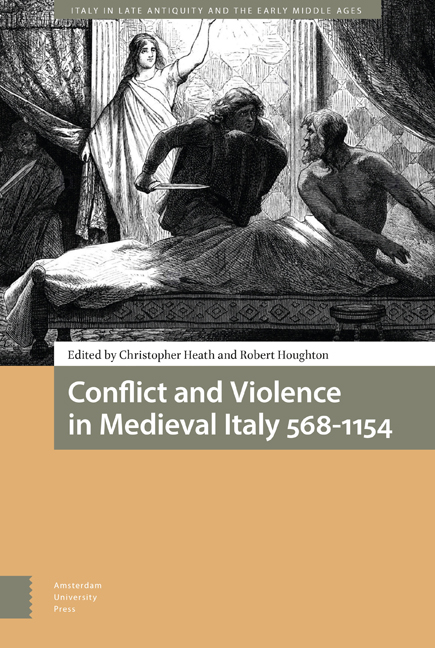Book contents
- Frontmatter
- Table of Contents
- Abbreviations
- Preface
- 1 Introduction: Discordant Minds and Hostile Nations
- 2 Morbidity and Murder: Lombard Kingship’s Violent Uncertainties 568-774
- 3 Insurgency and Counterinsurgency in Lombard Italy (c600-700)
- 4 Troubled Times: Narrating Conquest and Defiance between Charlemagne and Bernard (774-818)
- 5 ‘Nec patiaris populum Domini ab illis divinitus fulminandis Agarenis discerpi’: Handling ‘Saracen’ Violence in Ninth-Century Southern Italy
- 6 Formosus and the ‘Synod of the Corpse’: Tenth Century Rome in History and Memory
- 7 Sex, Denigration and Violence: A Representation of Political Competition between Two Aristocratic Families in Ninth Century Italy
- 8 ‘Italy and her [German] Invaders’: Otto III’s and Frederick Barbarossa’s Early Tours of Italy – Pomp, Generosity and Ferocity
- 9 ‘I Predict a Riot’: What Were the Parmense Rebelling Against in 1037?
- 10 The Strange Case of Deusdedit and Pandulf: Two Accounts of Honorius II’s Election
- Afterword
- Index
4 - Troubled Times: Narrating Conquest and Defiance between Charlemagne and Bernard (774-818)
Published online by Cambridge University Press: 07 September 2022
- Frontmatter
- Table of Contents
- Abbreviations
- Preface
- 1 Introduction: Discordant Minds and Hostile Nations
- 2 Morbidity and Murder: Lombard Kingship’s Violent Uncertainties 568-774
- 3 Insurgency and Counterinsurgency in Lombard Italy (c600-700)
- 4 Troubled Times: Narrating Conquest and Defiance between Charlemagne and Bernard (774-818)
- 5 ‘Nec patiaris populum Domini ab illis divinitus fulminandis Agarenis discerpi’: Handling ‘Saracen’ Violence in Ninth-Century Southern Italy
- 6 Formosus and the ‘Synod of the Corpse’: Tenth Century Rome in History and Memory
- 7 Sex, Denigration and Violence: A Representation of Political Competition between Two Aristocratic Families in Ninth Century Italy
- 8 ‘Italy and her [German] Invaders’: Otto III’s and Frederick Barbarossa’s Early Tours of Italy – Pomp, Generosity and Ferocity
- 9 ‘I Predict a Riot’: What Were the Parmense Rebelling Against in 1037?
- 10 The Strange Case of Deusdedit and Pandulf: Two Accounts of Honorius II’s Election
- Afterword
- Index
Summary
Abstract
The article focuses on four case studies, in order to understand the shifting discourse on conquest and resistance in Carolingian Italy: The 774 Frankish takeover of Italy, Hrodgaud's stand of 776, King Pippin's wars between 790 and 810, and King Bernard's rebellion of 818. From these episodes skilfully crafted stories were derived, where tradition and innovation shaped contemporary political concerns, often in conflict with each other. They offer a vantage point to observe the evolving fortunes of Carolingian Italy.
Keywords: Carolingian Italy; Pippin of Italy; Conquest; Rebellion; Lombards and Franks; Textual identities
Introduction
In 774 the Frankish armies of Charlemagne (768-814) conquered Italy, and founded a kingdom that was much greater in both extent and power than the kingdom of the Lombards. Under Frankish aegis, the Kings of Italy ruled over both Pavia and Ravenna – the cores of the Lombard and Roman polities of Italy – occasionally also extending their authority over the defiant Lombard duchies of the south, as well as the few surviving imperial enclaves such as Venice and the Puglian coast. Additionally, the rulers of Italy were granted authority over transalpine regions such as Istria, Bavaria, and eastern Alemannia, as well as hegemony over considerable but vaguely defined territories in central and south-eastern Europe. This substantial realm was a precarious one, and it did not long survive the death of its main architect: Charlemagne's third son, King Pippin (781-810). Indeed, two decades afterwards, the very fabric of the kingdom of Italy collapsed and powerful neighbours, both within and outside the Frankish world, took advantage of the realm's disarray.
These years are also blessed with many and rich sources, which narrate the rapidly changing nature of the Kingdom of Italy, from a hostile realm, to one among the cores of Frankish power, only to eventually re-emerge as a rebellious and treacherous kingdom a few decades later. Many authors concentrated on narrating war and disorder, which was read as the main vector for these transformations. Their stories were often built around a handful of Classical topoi. With few exceptions, they are repetitive and formulaic, closely resembling each other in plot: only very seldom has the course of the events been altered.
- Type
- Chapter
- Information
- Conflict and Violence in Medieval Italy 568-1154 , pp. 117 - 148Publisher: Amsterdam University PressPrint publication year: 2021



